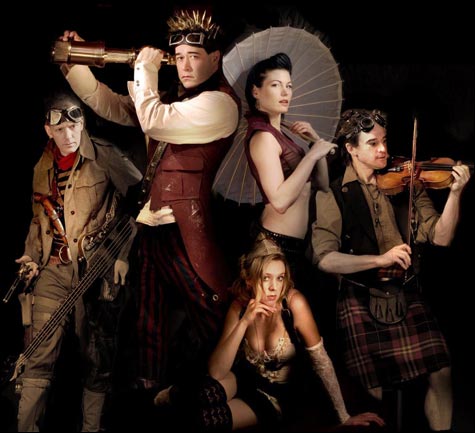“As we desperately fumble for a way to throw this machine into reverse,” says Dowling, “not just in the Steampunk scene but pan-culturally, I think it’s only natural that some people should manifest that desire by going back to the beginning — the Industrial Revolution and the Victorians. That’s where all this speculative fiction intersects with politics and the DIY movement — a desire to stand on the cusp of the industrialized, mass-marketed, engineered, branded iSpend future and the labor-intensive, technologically impoverished, hand-crafted past and ask: where did we go wrong? What could we have done differently? How can we re-imagine the fiction we will become in the future?”

STEAMPARK: Seattle five-piece Abney Park claim to be the crew of an airship, The Ophelia. |
Exposing the works
The cutting edge of tech-design seems defined by whatever Apple develops next. iMacs and iBooks and iPods are idolized for their contained, flawless, streamlined packaging. Anything that might be going on with the chips and wiring underneath the pristine casing remain a blind mystery to the user. Who gives a damn how it works, as long as it’s sleek and fits in your pocket?
“There’s no style left in craftsmanship,” says Rukstela. “I don’t look at anything made today, really, and think to myself, ‘somebody put a lot of thought into that.’ ” As a remedy, he founded Kinetic Steam Works (KSW), a 15-member Bay Area artist collective dedicated to creatively connecting steam power, kinetic art, and education. The group is made up of ex-NASA workers, senior design engineers, and gear-heads, and their mission as artists is one and the same: expose the works, and make an installation’s sweating innards beautiful and intrinsic to its design.
“I’m just a gear-head steamdork who likes to play with steam engines,” says Rukstela, who found himself spending a lot of time around “old-guy hobbies” when he was younger, learning to work on engines in what he calls the “old steam community.” He’d then go home to “do the exact same stuff as the industrial-warehouse rats, and use my industrial skills for creating art.” In 2002, Rukstela helped work on his friend Greg Jones’s Burning Man festival project, for which they crafted a downscaled 16th-century Spanish galleon and plunked it on top of a school bus. Shortly thereafter, Rukstela formed KSW, which he’s in the midst of turning into a nonprofit.
KSW debuted at Burning Man 2006 with Jamie Vaida’s steam-powered Carousel, and among their many surreal and fantastic projects are Sean Orlando’s Steampunk Tree House, another huge steam-powered hit at Burning Man this past August that looks like a miniaturized, darkwave version of Cinderella’s castle thrown into an Edward Gorey illustration, all twisted turrets and enchanted corners.
The allure of steam as both energy source and art form is something that’s not lost on Rukstela. “It’s quiet, it’s rhythmic, it’s hot,” he says. “It hisses and it’s got this real organic, crocodile-brain feel to it. It’s reciprocating motion, like watching a pinwheel.” This summer, KSW will team up with the New York guerilla street artist and wheat-paster Swoon on the Hudson River Project. They’ll spend three weeks on a sculptural flagship covered in Swoon’s art, trucking across the country with an armada of junk-built steamboats. The fleet will actually sail the Hudson River in mid August, culminating with a gallery show in Brooklyn.